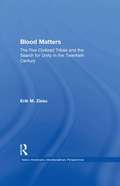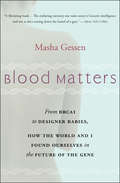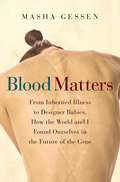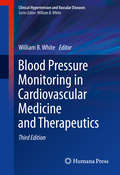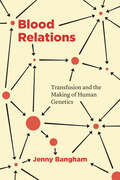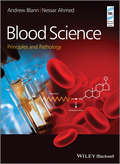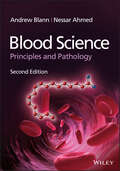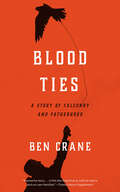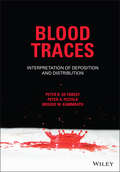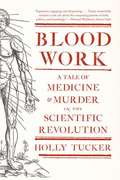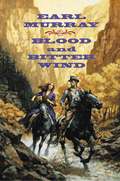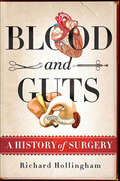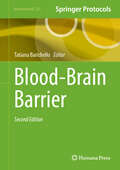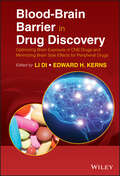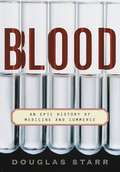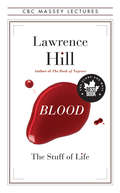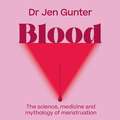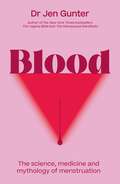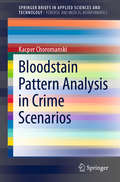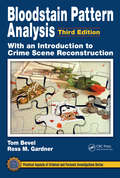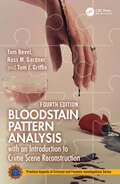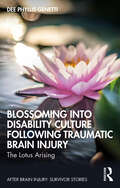- Table View
- List View
Blood Matters: Five Civilized Tribes and the Search of Unity in the 20th Century (Native Americans: Interdisciplinary Perspectives)
by Erik March ZissuThis study explores how the five tribes of Oklahoma - Cherokees, Chickasaws, Choctaws, Creeks, and Seminoles - strove to achieve political unity within their tribes during the first decades of the 20th century by forging a new sense of peoplehood around the idea of blood.
Blood Matters: From BRCA1 to Designer Babies, How the World and I Found Ourselves in the Future of the Gene
by Masha GessenA National Book Award winner&’s personal journey through the ethical dilemmas and unsettling choices raised by the new frontier of DNA testing. Several years after Masha Gessen&’s mother died of breast cancer, she discovered she too had the BRCA1 gene mutation, which predisposes women to high rates of ovarian and breast cancer. Her doctors gave her narrow options: surgical removal of her breasts and ovaries or living with the likelihood of one day developing cancer. As Gessen wrestled with her own health decisions, she sought more information about the implications of genetic testing from a variety of sources—ranging from others faced with her same dilemma to medical researchers, historians, and religious thinkers. With concerns both practical and philosophical, personal and societal, her inquiry led her across the globe, with stops in Israel, Russia, Austria, and the United States. Weaving her own story into her journalistic research, Gessen offers insight into how knowledge that was once unimaginable now shapes our lives. Blood Matters explores not only the decisions we must make in our physical and emotional health, but also the ethical choices we face when choosing spouses or having children. &“Valuable reading to almost anyone facing a huge health decision, not only for the literary commiseration it offers, but also for the inspired example of medical sleuthing on one&’s own behalf that it provides. Gessen keeps an inflammatory topic at room temperature, writing elegantly and without self pity.&” —The New York Times Book Review
Blood Matters: From Inherited Illness to Designer Babies, How the World and I Found Ourselves in the Future of the Gene
by Masha GessenIn 2004 genetic testing revealed that Masha Gessen had a mutation that predisposed her to ovarian and breast cancer. The discovery initiated Gessen into a club of sorts: the small (but exponentially expanding) group of people in possession of a new and different way of knowing themselves through what is inscribed in the strands of their DNA. As she wrestled with a wrenching personal decision--what to do with such knowledge--Gessen explored the landscape of this brave new world, speaking with others like her and with experts including medical researchers, historians, and religious thinkers. Blood Matters is a much-needed field guide to this unfamiliar and unsettling territory. It explores the way genetic information is shaping the decisions we make, not only about our physical and emotional health but about whom we marry, the children we bear, even the personality traits we long to have. And it helps us come to terms with the radical transformation that genetic information is engineering in our most basic sense of who we are and what we might become.
Blood Pressure Monitoring in Cardiovascular Medicine and Therapeutics (Clinical Hypertension and Vascular Diseases)
by William B. WhiteThis new edition is devoted to a broad array of topics involving the circadian variation in cardiovascular diseases, with focuses on hypertension, stroke, and coronary disease. The volume covers clinical and device research related to home and ambulatory BP monitoring, as there have been significant advances in technology since the publication of the previous edition. In addition, there is an increased focus on the applicability of home and ambulatory BP monitoring in drug development in all therapeutic arenas. The text features contributions from chapter authors from around the world and who have great expertise in cardiovascular medicine, therapeutics, clinical trials, and evidence-based medicine. Blood Pressure Monitoring in Cardiovascular Medicine and Therapeutics, Third Edition is essential reading for a large audience, including those practicing cardiology and nephrology with a special focus in hypertension, geriatrics and internal medicine, clinical trialists, regulators in the US, Europe, and Japan, and physicians in training in cardiology, hypertension, pharmacology, nephrology and neurology.
Blood Relations: Transfusion and the Making of Human Genetics
by Jenny BanghamBlood is messy, dangerous, and charged with meaning. By following it as it circulates through people and institutions, Jenny Bangham explores the intimate connections between the early infrastructures of blood transfusion and the development of human genetics. Focusing on mid-twentieth-century Britain, Blood Relations connects histories of eugenics to the local politics of giving blood, showing how the exchange of blood carved out networks that made human populations into objects of medical surveillance and scientific research. Bangham reveals how biology was transformed by two world wars, how scientists have worked to define racial categories, and how the practices and rhetoric of public health made genetics into a human science. Today, genetics is a powerful authority on human health and identity, and Blood Relations helps us understand how this authority was achieved.
Blood Science: Principles and Pathology
by Andrew Blann Nessar AhmedBlood Science is a relatively new discipline which merges biochemistry, haematology, immunology, transfusion science and genetics. This bringing together of traditional disciplines requires a corresponding change in education and training for healthcare scientists and Blood Science: Principles and Pathology is written in response to this emerging need. An introduction to the subject and an overview of the techniques used in blood science are followed by a series of chapters based on groups of analytes investigated in blood - red blood cells, white blood cells and platelets, followed by the constituents of plasma, including waste products, electrolytes, glucose, lipids, enzymes, hormones, nutrients, drugs, poisons and others. Each chapter is supported by learning objectives, summaries and further information, and a focus is given to chapter specific case studies with interpretation to demonstrate how laboratory data in conjunction with clinical details is utilised when investigating patients with actual or suspected disease. Finally, a separate chapter offers more detailed case reports that integrate the different aspects of blood science. Undergraduate students taking blood science modules as part of their BSc programmes in Biomedical and Healthcare Sciences will appreciate the level of integration between clinical biochemistry and haematology. In addition, this book will provide suitable initial reading for those students embarking on blood science modules on MSc programmes and will be of value to new graduates entering the profession and starting their career in blood science departments by supplementing practice-based training with the required theoretical underpinning. This book is approved by the Institute of Biomedical Science and written by its expert writers, many of whom work on the Institute’s advisory panels.
Blood Science: Principles and Pathology
by Andrew Blann Nessar AhmedBlood Science The second edition of the leading introduction to blood science, with updated new illustrations and case studies Blood Science: Principles and Pathology integrates hematology and blood transfusion, clinical biochemistry, and immunology to provide a thorough introduction to this rapidly expanding discipline. Reflecting recent changes in education and training for healthcare scientists, this comprehensive textbook covers the analytical techniques used in blood science, the diagnosis and management of various blood disorders, and more. Fully revised, the second edition presents new case studies and high-quality images throughout, illustrating the practical skills and knowledge required by today’s undergraduate students and practitioners. Detailed yet accessible chapters contain learning objectives and summaries, links to further readings and resources, and real-world case studies with easy-to-follow interpretations. Throughout the text, the authors highlight how laboratory data and clinical details are used to investigate patients with actual or suspected diseases in real-world scenarios: Multi-disciplinary view merging biochemical, hematological, immunological, and genetical knowledge into a single discipline: Blood science Discusses advances in molecular genetics identifying mutations resulting in the occurrence of certain pathological conditions such as leukaemia Presents an expanded concluding chapter with detailed case reports that integrate biochemistry, immunology, and haematology, which all contribute to the investigation of respective conditions Explains the potentials for developing tests such as non-coding RNAs Offers further reading suggestions to dive even deeper into discussed subjects and concepts Designed to meet the needs of undergraduate students taking blood science modules in biomedical, biological, and healthcare science programs, Blood Science: Principles and Pathology, Second Edition is also an invaluable guide for new graduates entering the field, as well as those training for professional qualifications or working with blood samples in laboratory-based environments.
Blood Ties: A Story of Falconry and Fatherhood
by Ben CraneRaised in rural England before the rise of the internet, Ben Crane grew up in the company of wild things, with hawks and other birds of prey alive in his mind—and woods and fields—as symbols of a kind of self-possessed, solitary power. He spent time with them, knew them, and loved them. But as Crane grew into adulthood, situations that may seem to many of us natural, or even comforting, were challenging: he found it difficult to be around other people and to read social cues, sometimes retreating in fear or lashing out in misunderstanding. Eventually, he was diagnosed as being on the autism spectrum. When Crane became a father, these challenges became unbearable, and he fled to isolation. Hawks brought him back. In this artful and moving memoir, we follow Crane on his remarkable journey of flight and return. Traveling from the United Kingdom to Pakistan, we learn first about the history and practice of falconry, a beautiful and brutal partnership between humans and birds that has persisted for thousands of years. And as Crane’s personal story unfolds, we come to understand how he found solace and insight through his relationships with these animals. “I saw that my feelings toward nature, and birds of prey in particular, ran in parallel with my feelings for my son,” Crane writes. “I worked out that they were, in fact, two sides of the same coin—the deep love of one could, with gentle observation, inform and unlock the deep love for the other. . . . Perhaps this then is the central theme of my story.” Many of us rely upon animal companions to provide a sense of joy, compassion, and empathy. But as Blood Ties teaches us, our relationships with the creatures among us can also transform us, illuminating what it means both to be human and to be part of the greater wild—what it means to be alive.
Blood Traces: Interpretation of Deposition and Distribution
by Brooke W. Kammrath Peter R. De Forest Peter A. PizzolaA guide to the scientific interpretation of blood traces Blood Traces provides an authoritative resource that reviews many of the aspects of the interpretation of blood traces that have not been treated with the thoroughness they deserve. With strict adherence to the scientific method, the authors — noted experts on the topic — address the complexities encountered when interpreting blood trace configurations. The book provides an understanding of the scientific basis for the use of blood trace deposits, i.e. bloodstain patterns, at crime scenes to better reconstruct a criminal event. The authors define eight overarching principles for the comprehensive analysis and interpretation of blood trace configurations. Three of these principles are: blood traces may reveal a great deal of useful information; extensive blood traces, although present, may not always yield information relevant to questions that may arise in a given case; and a collection of a few seemingly related dried blood droplet deposits is not necessarily an interpretable “pattern”. This important resource: Provides the fundamental principles for the scientific examination and understanding of blood trace deposits and configurations Dispels commonly accepted misinformation about blood traces. Contains a variety of illustrative case examples which will aid in demonstrating the concepts discussed Written for forensic scientists, crime scene investigators, members of the legal community, and students in these fields, Blood Traces presents the fundamental principles for the scientific examination of blood trace deposits and configurations.
Blood Work: A Tale of Medicine and Murder in the Scientific Revolution
by Holly Tucker"Excellent. . . . Tucker's chronicle of the world of 17th-century science in London and Paris is fascinating."--The Economist In December 1667, maverick physician Jean Denis transfused calf's blood into one of Paris's most notorious madmen. Days later, the madman was dead and Denis was framed for murder. A riveting exposé of the fierce debates, deadly politics, and cutthroat rivalries behind the first transfusion experiments, Blood Work takes us from dissection rooms in palaces to the streets of Paris, providing an unforgettable portrait of an era that wrestled with the same questions about morality and experimentation that haunt medical science today.
Blood Work: A Tale of Medicine and Murder tn the Scientific Revolution
by Holly TuckerTucker delivers a sharp-eyed expos of the deadly politics, murderous plots, and cutthroat rivalries behind the first blood transfusions in 17th-century Europe.
Blood and Bitter Wind
by Earl MurrayYou Can Almost Taste the Old West!Renowned for his detailed research and compelling characters, Earl Murray is an esteemed name in the historical fiction of the American Frontier and he proves it again in his newest novel of Old California.Los Angeles . . . in the1850s. John Dimas, a California Ranger goes undercover, following treacherous trails deep into the Sierra Nevada gold country in an attempt to do the impossible--infiltrate the elusive band of California's most notorious desperado, the feared Joaquin Murrieta. The course of this journey will take Dimas through a beautiful but perilous land, searching the daytime arenas where bullfights entertain bloodthirsty audiences, the midnight faro games and fandango halls where knife and pistol rule the night. Along the way, he will meet Maura Walsh, a beautiful lady of means come to unite with her fiancé, Trenton Kerns, a man with a dangerous connection to the evil and powerful Don Luis Markham. In a twist of treacherous fate, Dimas' secret mission will place him squarely in Markham's path. It is a confrontation he cannot hope to win. . . .Set against the raw turbulence and sudden violence of California's Gold Rush and the exploits of the famed Joaquin Murietta--the real-life inspiration for Zorro--Earl Murray's riveting new novel wonderfully re-creates a fascinating period in American history with the tension of a high-voltage thriller.
Blood and Guts: A History of Surgery
by Richard HollinghamToday, astonishing surgical breakthroughs are making limb transplants, face transplants, and a host of other previously un dreamed of operations possible. But getting here has not been a simple story of medical progress. In Blood and Guts, veteran science writer Richard Hollingham weaves a compelling narrative from the key moments in surgical history. We have a ringside seat in the operating theater of University College Hospital in London as world-renowned Victorian surgeon Robert Liston performs a remarkable amputation in thirty seconds—from first cut to final stitch. Innovations such as Joseph Lister's antiseptic technique, the first open-heart surgery, and Walter Freeman's lobotomy operations, among other breakthroughs, are brought to life in these pages in vivid detail. This is popular science writing at it's best.
Blood and Guts: A Working Guide to Your Own Insides
by Linda AllisonThis book discusses the elements of the human body and includes suggestions for related experiments and projects.
Blood-Brain Barrier (Neuromethods #221)
by Tatiana BarichelloThis volume details experimental research with applicable models to study physiology, biochemistry, and molecular biology of the blood-brain barrier (BBB). Chapters guide readers through the physiology of BBB, in vitro cell models to study the BBB, in vivo and ex vivo models to evaluate BBB, permeability, influx, efflux transportation, drug delivery through the BBB, invasive and non-invasive imaging techniques to study BBB; and molecular biomarkers. In Neuromethods series style, chapters include the kind of detail and key advice from the specialists needed to get successful results in your laboratory. Authoritative and cutting-edge, Blood-Brain Barrier aims to ensure successful results in the further study of this vital field.
Blood-Brain Barrier in Drug Discovery
by Edward H. Kerns Li DiFocused on central nervous system (CNS) drug discovery efforts, this book educates drug researchers about the blood-brain barrier (BBB) so they can affect important improvements in one of the most significant - and most challenging - areas of drug discovery.* Written by world experts to provide practical solutions to increase brain penetration or minimize CNS side-effects* Reviews state-of-the-art in silico, in vitro, and in vivo tools to assess brain penetration and advanced CNS drug delivery strategies* Covers BBB physiology, medicinal chemistry design principles, free drug hypothesis for the BBB, and transport mechanisms including passive diffusion, uptake/efflux transporters, and receptor-mediated processes* Highlights the advances in modelling BBB pharmacokinetics and dynamics relationships (PK/PD) and physiologically-based pharmacokinetics (PBPK)* Discusses case studies of successful CNS and non-CNS drugs, lessons learned and paths to the market
Blood: An Epic History of Medicine and Commerce
by Douglas StarrEssence and emblem of life--feared, revered, mythologized, and used in magic and medicine from earliest times--human blood is now the center of a huge, secretive, and often dangerous worldwide commerce. It is a commerce whose impact upon humanity rivals that of any other business--millions of lives have been saved by blood and its various derivatives, and tens of thousands of lives have been lost. Douglas Starr tells how this came to be, in a sweeping history that ranges through the centuries. With the dawn of science, blood came to be seen as a component of human anatomy, capable of being isolated, studied, used. Starr describes the first documented transfusion: In the seventeenth century, one of Louis XIV's court physicians transfers the blood of a calf into a madman to "cure" him. At the turn of the twentieth century a young researcher in Vienna identifies the basic blood groups, taking the first step toward successful transfusion. Then a New York doctor finds a way to stop blood from clotting, thereby making all transfusion possible.In the 1930s, a Russian physician, in grisly improvisation, successfully uses cadaver blood to help living patients--and realizes that blood can be stored. The first blood bank is soon operating in Chicago. During World War II, researchers, driven by battlefield needs, break down blood into usable components that are more easily stored and transported. This "fractionation" process--accomplished by a Harvard team--produces a host of pharmaceuticals, setting the stage for the global marketplace to come. Plasma, precisely because it can be made into long-lasting drugs, is shipped and traded for profit; today it is a $5 billion business. The author recounts the tragic spread of AIDS through the distribution of contaminated blood products, and describes why and how related scandals have erupted around the world. Finally, he looks at the latest attempts to make artificial blood. Douglas Starr has written a groundbreaking book that tackles a subject of universal and urgent importance and explores the perils and promises that lie ahead.
Blood: The Stuff of Life (The CBC Massey Lectures)
by Lawrence HillSelected for The Globe 100 Books in 2013. With the 2013 CBC Massey Lectures, bestselling author Lawrence Hill offers a provocative examination of the scientific and social history of blood, and on the ways that it unites and divides us today. Blood runs red through every person’s arteries and fulfills the same functions in every human being. The study of blood has advanced our understanding of biology and improved medical treatments, but its cultural and social representations have divided us perennially. Blood pulses through religion, literature, and the visual arts. Every time it pools or spills, we learn a little more about what brings human beings together and what pulls us apart. For centuries, perceptions of difference in our blood have separated people on the basis of gender, race, class, and nation. Ideas about blood purity have spawned rules about who gets to belong to a family or cultural group, who enjoys the rights of citizenship and nationality, what privileges one can expect to be granted or denied, whether you inherit poverty or the right to rule over the masses, what constitutes fair play in sport, and what defines a person’s identity. Blood: The Stuff of Life is a bold meditation on blood as an historical and contemporary marker of identity, belonging, gender, race, class, citizenship, athletic superiority, and nationhood.
Blood: The science, medicine and mythology of menstruation
by Dr. Jennifer Gunter'The world's most famous and outspoken gynaecologist' (The Guardian) fights myths and fearmongering with real science, inclusive facts, and shame-free advice on the topic that impacts more than 1.8 billion people worldwide: menstruation. Women can expect to have between 350 and 450 periods in a lifetime. So why is real information so hard to find? Despite its significance, most education about menstruation focuses either on increasing the chances of pregnancy or preventing it. And while both are crucial, women deserve to know more about their bodies than just what happens in service to reproduction. Not knowing how your body works makes it challenging to advocate for yourself. Consequently, many people suffer in silence thinking their bodies are uniquely broken or they turn to disreputable sources. Blood is a practical, empowering guide to what's typical, what's concerning and when to seek care - recounted with the no-nonsense expertise and frank, fearless wit that have made Dr Jen today's most trusted voice in women's health. Dr Jen answers all your period-related questions, including: What exactly happens during menstruation? How heavy is too heavy? How much should periods hurt? And provides essential information about topics such as: * The impact of stress and health on the menstrual cycle * Menstrual migraines, PMS and period diarrhea (yes, it's totally normal) * Polycystic Ovarian Syndrome (PCOS) and fibroids * Endometriosis and the latest treatments * The endometrium's (the uterine lining's) fascinating connection to the immune system * Different cultural perceptions of menstruation and how they affect girls and women * Menstruation and the trans and non-binary experience * Legitimate menstrual products and the facts behind toxic shock syndrome * The risks and benefits of hysterectomies Blood is about much more than biology. It's an all-in-one, revolutionary guide that will change the way we think about, talk about - and don't talk about - our bodies and our well-being.
Blood: The science, medicine and mythology of menstruation
by Dr. Jennifer Gunter'The world's most famous and outspoken gynaecologist' (The Guardian) fights myths and fearmongering with real science, inclusive facts, and shame-free advice on the topic that impacts more than 1.8 billion people worldwide: menstruation. Women can expect to have between 350 and 450 periods in a lifetime. So why is real information so hard to find? Despite its significance, most education about menstruation focuses either on increasing the chances of pregnancy or preventing it. And while both are crucial, women deserve to know more about their bodies than just what happens in service to reproduction. Not knowing how your body works makes it challenging to advocate for yourself. Consequently, many people suffer in silence thinking their bodies are uniquely broken or they turn to disreputable sources. Blood is a practical, empowering guide to what's typical, what's concerning and when to seek care - recounted with the no-nonsense expertise and frank, fearless wit that have made Dr Jen today's most trusted voice in women's health. Dr Jen answers all your period-related questions, including: What exactly happens during menstruation? How heavy is too heavy? How much should periods hurt? And provides essential information about topics such as: * The impact of stress and health on the menstrual cycle * Menstrual migraines, PMS and period diarrhea (yes, it's totally normal) * Polycystic Ovarian Syndrome (PCOS) and fibroids * Endometriosis and the latest treatments * The endometrium's (the uterine lining's) fascinating connection to the immune system * Different cultural perceptions of menstruation and how they affect girls and women * Menstruation and the trans and non-binary experience * Legitimate menstrual products and the facts behind toxic shock syndrome * The risks and benefits of hysterectomies Blood is about much more than biology. It's an all-in-one, revolutionary guide that will change the way we think about, talk about - and don't talk about - our bodies and our well-being.
Bloodborne Pathogens: Provider Handbook
by Dr Karl DisqueWelcome to the Save a Life Initiative: Bloodborne Pathogens Course. This course is intended to help you prepare to address the health concerns inherent in caring for others and the possible damage the microscopic world can inflict. Unlike traditional academic curricula, you will learn actionable ways to practice and prepare for the bacteria and pathogens you may encounter in your career. If you become exposed to bloodborne pathogens, you will have the knowledge to reduce the chances of disease transmission and protect others, including co-workers and patients, from possible infection. This course consists of the materials and information necessary to protect yourself and those around you from being exposed to blood or blood-containing items that you may come into contact with throughout the course of your job. This training may be required as part of your training for bloodborne pathogens by your employer. In addition, such training is required annually by the Occupational and Safety Health Administration (OSHA). Your employer will provide you with additional training, which will be referred to as an Exposure Control Plan (ECP), on bloodborne pathogens as indicated by your role and responsibilities in your organization. This course is written by Dr. Karl F. Disque, a board certified anesthesiologist and registered pharmacist. Dr. Disque has certified thousands of healthcare professionals with his courses in CPR, AED, and First Aid, Advanced Cardiac Life Support (ACLS), Pediatric Advanced Life Support (PALS), and Basic Life Support (BLS). This is one of the most effective and user-friendly training manuals on the market because it was created by a team dedicated to life support education with the goal of training people to help save lives. This manual is the primary training material for certification courses provided by National Health Care Provider Solutions (www.nhcps.com).
Bloodstain Pattern Analysis in Crime Scenarios (SpringerBriefs in Applied Sciences and Technology)
by Kacper ChoromanskiThis book introduces the core concepts of bloodstain pattern analysis that help to understand and make independent contributions to crime scenes accurately. It presents a bridge between new research results and the practical work field of crime scene investigation in bloodstain pattern analysis, by showing and detailing reports of two different scenarios. The scenarios presented have an extensive description of gathered evidence and are diversified with real crime scene photography and sketches. This kind of case report is rare in scientific books, but the author, as a researcher, has permission from the authorities to present the cases. The book finally concludes with the main problems of modern bloodstain pattern analysis and discusses the way forward.
Bloodstain Pattern Analysis with an Introduction to Crime Scene Reconstruction (ISSN)
by Ross M. Gardner Tom BevelObjective establishment of the truth is the goal of any good crime scene investigator. This demands a consideration of all evidence available using proven scientific methodologies to establish objective snapshots of the crime. The majority of forensic disciplines shed light on thewho of a crime, bloodstain pattern analysis is one of the most imp
Bloodstain Pattern Analysis with an Introduction to Crime Scene Reconstruction (Practical Aspects of Criminal and Forensic Investigations)
by Ross M. Gardner Tom Bevel Tom J. GriffinBlood Stain Pattern Analysis with an Introduction to Crime Scene Reconstruction, Fourth Edition provides criminal investigators and forensic scientists with a complete and comprehensive handbook on bloodstain pattern analysis.Bringing over 90 combined years of practical experience—and thousands of cases worked collectively—the authors explain the complex mechanics of blood spatter analysis, including anatomical issues relative to bloodstain pattern analysis, a discussion of blood and the circulatory system, and the nature of bleeding associated with various traumatic and non-traumatic injuries. The book also details specific methodologies for crime scene analysis and reconstruction, explaining the proven methodology involved in the process. Such methodology is built upon scientific method and provides focus and structure to the analyst as they evaluate evidence and conduct their work and the investigation.Finally, all chapters are fully revised and updated to address the latest taxonomy and terminology, with over 400 full-color photographs included to illustrate the dynamics of bloodstain pattern analysis.Key features: Presents a specific and detailed taxonomy of bloodstain pattern characteristics, outlining recently updated NIST’s OSAC terminology Includes two full-color fold-outs Decision Map to guide analysts through the classification process Details the theory, principles, and methodology for crime scene reconstruction Expands the bloodstain on clothing chapter, to include new developments in the understanding of bloodstain features and characteristics on cloth Offering practical advice and tips for new and experienced professionals alike, Blood Stain Pattern Analysis with an Introduction to Crime Scene Reconstruction, Fourth Edition offers readers the necessary tools to guide and focus any investigative effort.
Blossoming Into Disability Culture Following Traumatic Brain Injury: The Lotus Arising (ISSN)
by Dee Phyllis GenettiThis book tells the author’s story of her ten-year journey of recovery and identity transformation from Traumatic Brain Injury (TBI). Dr. Dee is a survivor who regained the ability to articulate what many TBI survivors cannot, and this powerful account, provided in real-time, portrays the many seemingly unrelatable symptoms of brain injury and subsequent post-traumatic stress disorder (PTSD). Dr. Dee portrays how events pushed her beyond her limits and resulted in life-altering learning experiences, revealing a process of first figuring out how to live, then making meaning of her struggle.When half-way through her PhD program, Dr. Dee was crashed into by a car travelling at 65 miles per hour. She suffered a TBI. She lost her ability to read and write. She had a severe speech impediment and significantly impaired memory. Her journey of recovery, described in the book as her trek, spans four significant periods. The road begins with the loss of most of herself. Diagnosis and evolving symptoms show her broken pathway. The author goes through a rocky road of changes in her relationships and reidentification of herself as she finds her life coach, re-learns to read and write, and deals with mental health issues that felt like the end of her recovery. The final trek reveals hope and posttraumatic growth (PTG) and showcases the value of Disability Culture as a source of pride.This story is for fellow TBI survivors, their caretakers, families and friends, and professionals in the neurorehabilitation field. It brings light to the daunting changes after TBI and give hope for all who tread on this challenging path.
